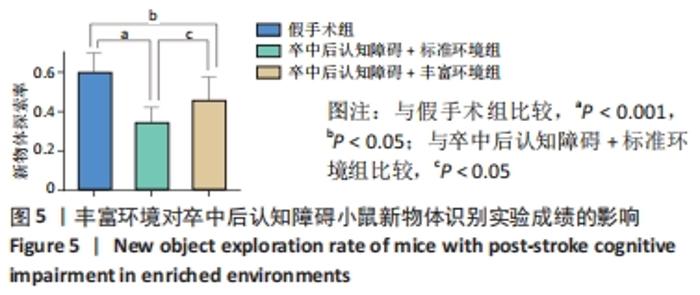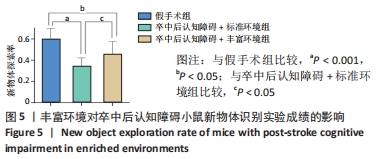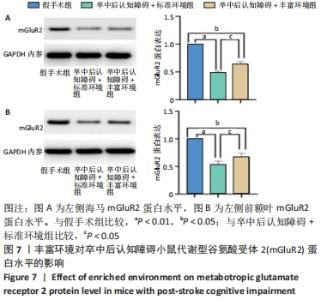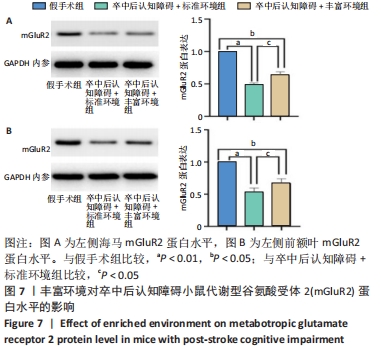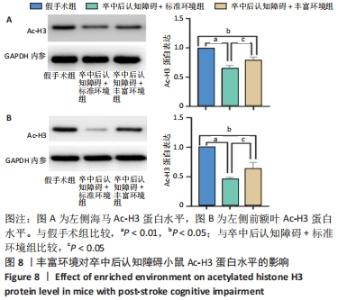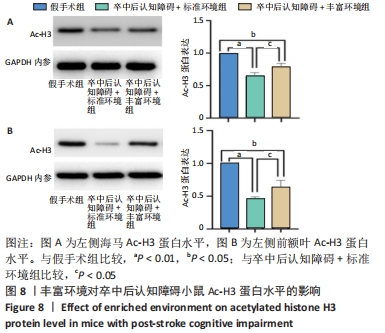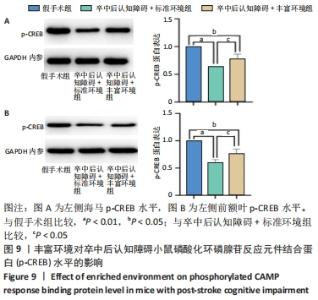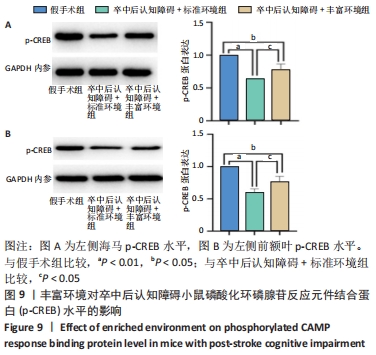Chinese Journal of Tissue Engineering Research ›› 2022, Vol. 26 ›› Issue (23): 3676-3682.doi: 10.12307/2022.667
Previous Articles Next Articles
Metabotropic glutamate receptor improves post-stroke cognitive impairment in enriched environments
Liu Jiayu1, Yan Ping1, Zhang Yu1, Zhou Hongyu2, Wang Xin2
- 1School of Nursing, Yangzhou University, Yangzhou 225002, Jiangsu Province, China; 2Clinical Medical College of Yangzhou University, Yangzhou 225002, Jiangsu Province, China
-
Received:2021-02-08Accepted:2021-03-16Online:2022-08-18Published:2022-02-15 -
Contact:Wang Xin, MD, Chief physician, Associate professor, Clinical Medical College of Yangzhou University, Yangzhou 225002, Jiangsu Province, China -
About author:Liu Jiayu, Master, School of Nursing, Yangzhou University, Yangzhou 225002, Jiangsu Province, China -
Supported by:the Natural Science Foundation of Jiangsu Province, No. BK20171280 (to WX); “Huxin Fund” Project of Jiangsu Key Laboratory of Zoonosis, No. HX2003 (to WX)
CLC Number:
Cite this article
Liu Jiayu, Yan Ping, Zhang Yu, Zhou Hongyu, Wang Xin. Metabotropic glutamate receptor improves post-stroke cognitive impairment in enriched environments[J]. Chinese Journal of Tissue Engineering Research, 2022, 26(23): 3676-3682.
share this article
Add to citation manager EndNote|Reference Manager|ProCite|BibTeX|RefWorks
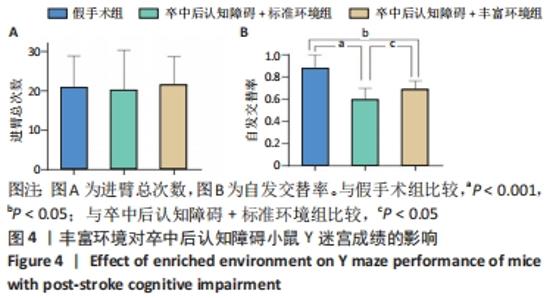
2.1 实验动物数量分析 选择健康成年小鼠30只,随机分为3组,每组10只,实验过程中无脱失,所有反应均计入结果分析。 2.2 丰富环境对PSCI小鼠Y迷宫成绩的影响 3组之间进入每臂总数差异无显著性意义(P > 0.05),见图4A。PSCI+标准环境组小鼠的自发交替率较假手术组明显降低,组间差异有显著性意义(P < 0.001),提示PSCI小鼠工作记忆功能显著受损。PSCI+丰富环境组小鼠的自发交替率较PSCI +标准环境组明显改善(P < 0.01),说明丰富环境饲养后,PSCI小鼠的工作记忆有所提升。但PSCI+丰富环境组上述指标和假手术组相比差异仍有显著性意义(P < 0.05),可见丰富环境干预能在很大程度上提高认知功能障碍小鼠的记忆,不过仍然不能达到正常水平,见图4B。"
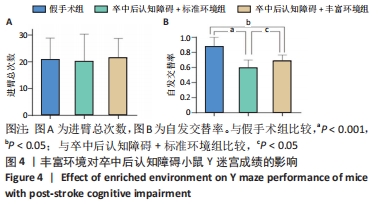

2.4 丰富环境对PSCI小鼠前额叶及海马mGluR2 mRNA水平的影响 与假手术+标准环境组小鼠相比,PSCI+标准环境组小鼠左侧前额叶皮质mGluR2 mRNA水平明显降低(P < 0.01);经丰富环境饲养后,PSCI+丰富环境组小鼠mGluR2 mRNA水平较PSCI+标准环境组显著升高(P < 0.05),但与假手术组相比差异仍有显著性意义(P < 0.05);说明丰富环境饲养后,PSCI小鼠的mGluR2 mRNA有所提升,但还无法使其完全恢复至正常水平,见图6A。PSCI+标准环境组小鼠左侧海马mGluR2 mRNA水平明显低于假手术组(P < 0.01),PSCI+丰富环境组小鼠的mGluR2 mRNA水平较PSCI +标准环境组明显改善(P < 0.05),但与假手术组相比差异仍有显著性意义(P < 0.05),见图6B。"
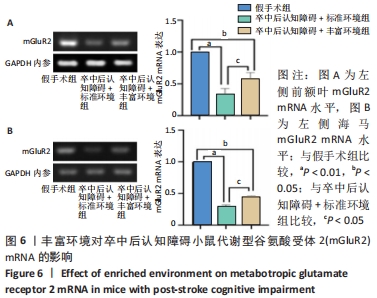
| [1] 严兴丽,冶生寿,祁秀丽.脑卒中患者血清细胞因子水平与血管性认知障碍相关性分析[J].神经损伤与功能重建,2019,14(9):469-471. [2] 周卫红.延续性护理教育在脑卒中病人及其主要照顾者中的应用[J].护理研究,2021,35(1):172-176. [3] 车文生, 蔡琛. 认知康复训练结合头皮针治疗脑卒中后认知功能障碍的疗效观察[J]. 中国实用神经疾病杂志,2018,21(24):2719-2724. [4] 张立,赵小娟,张继瑶,等.脑卒中后认知障碍的康复治疗进展[J].辽宁中医药大学学报:1-10[2021-05-20].http://kns.cnki.net/kcms/detail/21.1543.R. 20210426.1323.016.html. [5] KALARIA RN, AKINYEMI R, IHARA M. Stroke injury, cognitive impairment and vascular dementia. Biochim Biophys Acta. 2016;1862(5):915-925. [6] YANG CC, CHIU MJ, CHEN TF, et al. Assay of Plasma Phosphorylated Tau Protein (Threonine 181) and Total Tau Protein in Early-Stage Alzheimer’s Disease. J Alzheimers Dis. 2018;61(4):1323-1332. [7] WEAVER NA, KUIJF HJ, ABEN HP, et al. Strategic infarct locations for post-stroke cognitive impairment: a pooled analysis of individual patient data from 12 acute ischaemic stroke cohorts. Lancet Neurol. 2021;211: 65-74. [8] CASOLLA B, CAPARROS F, CORDONNIER C, et al. Biological and imaging predictors of cognitive impairment after stroke: a systematic review. J Neurol. 2019;266(11): 2593-2604. [9] BRAININ M, TUOMILEHTO J, HEISS WD, et al. Post-stroke cognitive decline: an update and perspectives for clinical research. Eur J Neurol. 2015;22(2):229-238, e213-226. [10] KIM JY, KANG K, KANG J, et al. Executive Summary of Stroke Statistics in Korea 2018: A Report from the Epidemiology Research Council of the Korean Stroke Society. J Stroke. 2019;21(1):42-59. [11] WANG X, CHEN A, WU H, et al. Enriched environment improves post-stroke cognitive impairment in mice by potential regulation of acetylation homeostasis in cholinergic circuits. Brain Res. 2016;1650:232-242. [12] YU K, WU Y, ZHANG Q, et al. Enriched environment induces angiogenesis and improves neural function outcomes in rat stroke model. J Neurol Sci. 2014;347(1-2): 275-280. [13] Zhu YT, Zhang Q, Xie HY, et al. Environmental enrichment combined with fasudil promotes motor function recovery and axonal regeneration after stroke. Neural Regen Res. 2021;16(12):2512-2520. [14] WANG X, PATEL ND, HUI D, et al. Gene expression patterns in the hippocampus during the development and aging of Glud1 (Glutamate Dehydrogenase 1) transgenic and wild type mice. BMC Neurosci. 2014;15:37. [15] GASPARINI CF, SUTHERLAND HG, HAUPT LM, et al. Genetic analysis of GRIA2 and GRIA4 genes in migraine. Headache. 2014;54(2):303-312. [16] 王颖怡,吕钦谕,陆燕华,等.谷氨酸受体与精神分裂症治疗的研究进展[J].中国医药导报,2019,16(22):42-45+65. [17] MOTOLESE M, MASTROIACOVO F, CANNELLA M, et al. Targeting type-2 metabotropic glutamate receptors to protect vulnerable hippocampal neurons against ischemic damage. Mol Brain. 2015;8(1):66. [18] MOHAMED NE, ZHAO Y, LEE JH, et al. Upregulation of AMPA receptor GluR2 (GluA2) subunits in subcortical ischemic vascular dementia is repressed in the presence of Alzheimer’s disease. Neurochem Int. 2011;58(7):820-825. [19] YANG J, YAO Y, WANG L, et al. Gastrin-releasing peptide facilitates glutamatergic transmission in the hippocampus and effectively prevents vascular dementia induced cognitive and synaptic plasticity deficits. Exp Neurol. 2017;287(Pt 1):75-83. [20] LI M, LIU Y, CHEN J, et al. Platelet bio-nanobubbles as microvascular recanalization nanoformulation for acute ischemic stroke lesion theranostics. Theranostics. 2018;8(18):4870-4883. [21] 翟羽佳, 穆寒露, 何蓉蓉, 等. 光照血栓中风模型的研究进展[J]. 中国比较医学杂志,2019,29(8):135-141. [22] WANG Y, WU J, XIE H, et al. Enriched Environment Promotes Cognitive Function Recovery following Cerebral Ischemic Injury via Upregulating GABAergic and Glutamatergic Systems in the Contralateral Hippocampus. Evid Based Complement Alternat Med. 2020;2020:8850119. [23] KUBO KY, OGASAWARA A, TSUGANE H, et al. Environmental enrichment improves hypomyelination, synaptic alterations, and memory deficits caused by tooth loss in aged SAMP8 mice. Arch Oral Biol. 2021;123:105039. [24] YUAN M, ZHANG XX, FU XC, et al. Enriched environment alleviates post-stroke cognitive impairment through enhancing α7-nAChR expression in rats. Arq Neuropsiquiatr. 2020;78(10):603-610. [25] 金信浩. 丰富环境改善血管性痴呆大鼠学习和空间记忆能力及其机制研究[D]. 重庆: 重庆医科大学,2017. [26] WANG X, MENG Z, WANG J, et al. Enriched environment improves working memory impairment of mice with traumatic brain injury by enhancing histone acetylation in the prefrontal cortex. Peer J. 2018;6:e6113. [27] JIN X, LI T, ZHANG L, et al. Environmental Enrichment Improves Spatial Learning and Memory in Vascular Dementia Rats with Activation of Wnt/β-Catenin Signal Pathway. Med Sci Monit. 2017;23:207-215. [28] AKBARI P, NAJAFI M, REZAEI AM, et al. Enriched Environment Ameliorates Cognitive Deficits and Locomotor Sensitization in Morphine-Withdrawn Rats Receiving Methadone Maintenance Treatment. Neuropsychobiology. 2020;79(6):437-444. [29] GIACOBBO BL, DE FREITAS BS, VEDOVELLI K, et al. Long-term environmental modifications affect BDNF concentrations in rat hippocampus, but not in serum. Behav Brain Res. 2019;372:111965. [30] CHEN P, LI X. Study on Effect of Striatal mGluR2/3 in Alleviating Motor Dysfunction in Rat PD Model Treated by Exercise Therapy. Front Aging Neurosci. 2019;11:255. [31] WANG X, LI J, QIAN L, et al. Icariin promotes histone acetylation and attenuates post-stroke cognitive impairment in the central cholinergic circuits of mice. Neuroscience. 2013;236:281-288. [32] TUCKER LB, FU AH, MCCABE JT. Performance of Male and Female C57BL/6J Mice on Motor and Cognitive Tasks Commonly Used in Pre-Clinical Traumatic Brain Injury Research. J Neurotrauma. 2016;33(9):880-894. [33] KRAEUTER AK, GUEST PC, SARNYAI Z. The Y-Maze for Assessment of Spatial Working and Reference Memory in Mice. Methods Mol Biol. 2019;1916:105-111. [34] ZHANG Y, SUN Q, FAN A, et al. Isoflurane triggers the acute cognitive impairment of aged rats by damaging hippocampal neurons via the NR2B/CaMKII/CREB pathway. Behav Brain Res. 2021;405:113202. [35] GASPARY KV, REOLON GK, GUSSO D, et al. Novel object recognition and object location tasks in zebrafish: Influence of habituation and NMDA receptor antagonism. Neurobiol Learn Mem. 2018;155:249-260. [36] 邢敏, 毛敬洁, 陈文列, 等. APP/PS1双转基因AD模型小鼠海马区磁共振波谱和超微结构分析[J]. 中国实验动物学报,2020,28(2):236-241. [37] ZARE D, RAJIZADEH MA, MANESHIAN M, et al. Inhibition of protease-activated receptor 1 (PAR1) ameliorates cognitive performance and synaptic plasticity impairments in animal model of Alzheimer’s diseases. Psychopharmacology (Berl). 2021;238(6):1645-1656. [38] LI PC, JIAO Y, DING J, et al. Cystamine improves functional recovery via axon remodeling and neuroprotection after stroke in mice. CNS Neurosci Ther. 2015; 21(3):231-240. [39] WANG H, XU X, XU X, et al. Enriched Environment and Social Isolation Affect Cognition Ability via Altering Excitatory and Inhibitory Synaptic Density in Mice Hippocampus. Neurochem Res. 2020;45(10):2417-2432. [40] MURUETA-GOYENA A, ORTUZAR N, GARGIULO P, et al. Short-Term Exposure to Enriched Environment in Adult Rats Restores MK-801-Induced Cognitive Deficits and GABAergic Interneuron Immunoreactivity Loss. Mol Neurobiol. 2018;55(1): 26-41. [41] XING R, ZHANG Y, XU H, et al. Spatial memory impairment by TRPC1 depletion is ameliorated by environmental enrichment. Oncotarget. 2016;7(19):27855-27873. [42] CHRISTIANSEN GB, HARBAK B, HEDE SE, et al. A novel dualistic profile of an allosteric AMPA receptor modulator identified through studies on recombinant receptors, mouse hippocampal synapses and crystal structures. Neuroscience. 2015;310:709-722. [43] LYON L, BURNET PW, KEW JN, et al. Fractionation of spatial memory in GRM2/3 (mGlu2/mGlu3) double knockout mice reveals a role for group II metabotropic glutamate receptors at the interface between arousal and cognition. Neuropsychopharmacology. 2011;36(13):2616-2628. [44] COUNOTTE DS, GORIOUNOVA NA, LI KW, et al. Lasting synaptic changes underlie attention deficits caused by nicotine exposure during adolescence. Nat Neurosci. 2011;14(4):417-419. [45] HIKICHI H, KAKU A, KARASAWA J, et al. Stimulation of metabotropic glutamate (mGlu) 2 receptor and blockade of mGlu1 receptor improve social memory impairment elicited by MK-801 in rats. J Pharmacol Sci. 2013;122(1):10-16. [46] WANG X, MENG ZX, CHEN YZ, et al. Enriched environment enhances histone acetylation of NMDA receptor in the hippocampus and improves cognitive dysfunction in aged mice. Neural Regen Res. 2020;15(12):2327-2334. [47] 房慧媚, 贾瑞璇, 李凤迪, 等. 凉血消风汤对血热型寻常性银屑病患者外周血淋巴细胞乙酰化内稳态的影响[J]. 中国皮肤性病学杂志,2017,31(9):1021-1023. [48] TRACY T, CLAIBORN KC, GAN L. Regulation of Tau Homeostasis and Toxicity by Acetylation. Adv Exp Med Biol. 2019;1184:47-55. [49] 施学丽, 李玲, 曹智怡, 等. CREB信号通路与抗抑郁中药关系的研究进展[J]. 神经解剖学杂志,2020,36(3):349-352. [50] SHARMA VK, SINGH TG. CREB: A Multifaceted Target for Alzheimer’s Disease. Curr Alzheimer Res. 2020;17(14):1280-1293. [51] LOPEZ-ATALAYA JP, CICCARELLI A, VIOSCA J, et al. CBP is required for environmental enrichment-induced neurogenesis and cognitive enhancement. EMBO J. 2011;30(20):4287-4298. [52] NAQVI S, MARTIN KJ, ARTHUR JS. CREB phosphorylation at Ser133 regulates transcription via distinct mechanisms downstream of cAMP and MAPK signalling. Biochem J. 2014;458(3):469-479. |
| [1] | Zhao Jing, Liu Xiaobo, Zhang Yue, Zhang Jiaming, Zhong Dongling, Li Juan, Jin Rongjiang. Visualization analysis of neuromuscular electrical stimulation therapy based on CiteSpace: therapeutic effects, hot spots, and developmental trends [J]. Chinese Journal of Tissue Engineering Research, 2022, 26(8): 1234-1241. |
| [2] | Tang Wenjing, Wu Siyuan, Yang Chen, Tao Xi. Inflammatory responses in post-stroke depression [J]. Chinese Journal of Tissue Engineering Research, 2022, 26(8): 1278-1285. |
| [3] | Fang Xiaolei, Leng Jun, Zhang Chen, Liu Huimin, Guo Wen. Systematic evaluation of different therapeutic effects of mesenchymal stem cell transplantation in the treatment of ischemic stroke [J]. Chinese Journal of Tissue Engineering Research, 2022, 26(7): 1085-1092. |
| [4] | Chen Na, Wang Xiaohan, Zhang Yunke. Effect and mechanism of mesenchymal stem cells on aging-related ischemic stroke [J]. Chinese Journal of Tissue Engineering Research, 2022, 26(24): 3914-3920. |
| [5] | Yan Nan, Wu Yanlong, Tang Xiaohui, Zhang Xiaoyan, Wang Hui, Yang Tianze, Zhou Maochun, Wang Zhengdong, Yang Xiaoxia. Bone marrow mesenchymal stem cells may alleviate brain damage caused by the microglial overactivation in the cortex around ischemic site of stroke [J]. Chinese Journal of Tissue Engineering Research, 2022, 26(24): 3790-3795. |
| [6] | Xu Wenshan, Jiang Pingli, Liu Yulu, Ding Yanyi, Yu Yan, Yang Minguang, Liu Weilin, Chen Lidian. Salvianolic acid A effects on hippocampal protein expression in ischemic stroke rats: a tandem mass tag-based proteomic analysis [J]. Chinese Journal of Tissue Engineering Research, 2022, 26(23): 3714-3720. |
| [7] | Xiakeerzhati•Xiaohalati, Wang Xiaobei, Wang Lin. Nanoparticles: a novel strategy for the treatment of ischemic stroke [J]. Chinese Journal of Tissue Engineering Research, 2022, 26(22): 3566-3572. |
| [8] | Li Shulun, Hao Peng, Hao Fei, Duan Hongmei, Zhao Wen, Gao Yudan, Yang Chaoyang, Li Xiaoguang. Pathological changes in rats with ischemic stroke induced by improved photochemical embolization [J]. Chinese Journal of Tissue Engineering Research, 2022, 26(2): 218-224. |
| [9] | Yang Yanwen, Zhang Jing, Mao Yuling, Ni Jun, Mao Libin, Yao Lu, Wang Huiying, Liu Qiuming, Ma Zhenzhen. Establishment of a severe heatstroke pig model under high-temperature and high-humidity environment [J]. Chinese Journal of Tissue Engineering Research, 2022, 26(17): 2678-2684. |
| [10] | Xiao Xiang, Huang Dongfeng. Virtual reality training improves motor function of the upper limbs in stroke survivors: an evaluation using transcranial magnetic stimulation [J]. Chinese Journal of Tissue Engineering Research, 2022, 26(17): 2756-2761. |
| [11] | Chen Na, Fan Feiyan, Li Shuangli, Zhang Yunke. Effect and mechanism of traditional Chinese medicine regulating mesenchymal stem cell-derived exocrine for ischemic stroke [J]. Chinese Journal of Tissue Engineering Research, 2022, 26(13): 2081-2086. |
| [12] | Yuan Mei, Zhang Xinxin, Guo Yisha, Bi Xia. Diagnostic potential of circulating microRNA in vascular cognitive impairment [J]. Chinese Journal of Tissue Engineering Research, 2021, 25(8): 1299-1304. |
| [13] | Zhang Jiaming, Tian Yanping, Zhang Yue, Zhong Dongling, Li Yuxi, Zheng Zhong, Li Juan, Jin Rongjiang. Visual analysis of literature on transcranial magnetic stimulation for stroke based on Citespace knowledge map [J]. Chinese Journal of Tissue Engineering Research, 2021, 25(35): 5610-5618. |
| [14] | Guo Wen, Leng Jun, Liu Huimin, Zhang Chen, Fang Xiaolei, Wei Fangyue. Visual analysis of literature regarding post-stroke urinary incontinence in the past 10 years [J]. Chinese Journal of Tissue Engineering Research, 2021, 25(35): 5676-5681. |
| [15] | Yuan Chunhua, Cui Zhenzhen, Wu De. Meta-analysis of autologous bone marrow mesenchymal stem cell transplantation in the treatment of ischemic stroke [J]. Chinese Journal of Tissue Engineering Research, 2021, 25(31): 5018-5024. |
| Viewed | ||||||
|
Full text |
|
|||||
|
Abstract |
|
|||||
